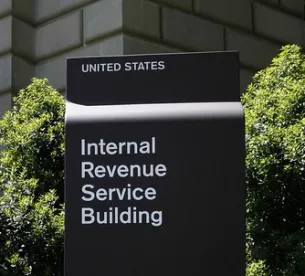On December 13, 2018, the Internal Revenue Service (the “IRS”) and the Department of the Treasury (the “Treasury”) released proposed regulations (the “Proposed Regulations”) with respect to the “base erosion and anti-abuse tax” (the “BEAT”) under section 59A of the Internal Revenue Code.[1]
The BEAT was enacted in 2017 as part of the tax reform act.[2] The BEAT is an additional tax that has the effect of a minimum tax on certain large U.S. corporations that make deductible payments to foreign related parties. The BEAT is designed to prevent these U.S. corporations from using deductible payments to reduce (or “base erode”) their corporate tax liability.
The Proposed Regulations clarify which taxpayers are subject to the BEAT and how the BEAT rules apply. The Proposed Regulations are generally effective for taxable years after December 31, 2017, and a taxpayer may rely on them before they are finalized so long as the taxpayer applies them consistently for all taxable years before they are finalized.
Summary of the Proposed Regulations
The Proposed Regulations provide guidance regarding which taxpayers are subject to the BEAT, which payments give rise to base erosion tax benefits, the calculation of modified taxable income, and certain exceptions to the BEAT. In short, under the Proposed Regulations:
- Base erosion payments do not include gross receipts of a foreign taxpayer to the extent they are “effectively connected with a U.S. trade or business” or, if there is an applicable treaty, are taken into account in determining a foreign member’s net taxable income.
- Foreign currency losses are excluded from the base erosion percentage computation.
- Partnerships are treated as an aggregate of partners rather than as entities for purposes of the BEAT.
- Base erosion payments may include amounts paid or accrued by the taxpayer to a foreign related party in cash or in any non-cash consideration, such as amounts arising from tax-free transactions that involve the acquisition of depreciable or amortizable property. Accordingly, even though a transaction may be tax-free for federal tax purposes generally, the transaction may be deemed to create base erosion payments that are subject to the BEAT.
- Base erosion payments do not generally include payments that are included in the cost of goods sold or otherwise reduce gross receipts and general tax principles apply in determining whether a payment is treated as deductible or as other than deductible for BEAT purposes.
- Service payments with a markup component are not eligible for the services cost method exception only to the extent that the portion of the payment exceeds of the total cost of services.
- While reinsurance agreements and other commercial agreements may provide that payments to and from a reinsurer are settled on a net basis under the terms of the agreement, the Proposed Regulations create gross payments from the net amounts for purposes of determining the amount of any base erosion payment attributable to these agreements.
- Deductions arising from NOL carryovers do not reduce taxable income below zero for purposes of the BEAT and the base erosion percentage for NOLs is the base erosion percentage for the year in which the loss arose.
- Certain transactions will be disregarded and recharacterized if they have a principal purpose of avoiding application of the BEAT.
Background
The BEAT applies only to “applicable taxpayers.” An applicable taxpayer is a taxpayer that (i) is a corporation other than a regulated investment company (“RIC”), real estate investment company (“REIT”), or an S corporation, (ii) has average annual gross receipts of $500 million for three taxable years immediately preceding the current year (the “gross receipts test”), and (iii) has tax benefits from “base erosion payments” (as described below) that account for 3% or more of its total deductions (or 2% for banks or registered securities dealers).[3] For purposes of determining whether these requirements are satisfied, taxpayers that are treated as a single employer under section 52(a) are treated as a single person.[4] In addition, for this purpose, the gross receipts of a foreign taxpayer includes only gross receipts that are “effectively connected with a U.S. trade or business” (“effectively connected income,” or “ECI”).[5]
If the BEAT applies to a taxpayer (i.e., the taxpayer is an “applicable taxpayer”), the additional tax is equal to the excess of 10%[6] of the taxpayer’s “modified taxable income” over its “regular tax liability,” reduced (but not below zero) by all foreign tax credits and certain other tax credits. For this purpose, modified taxable income generally means the applicable taxpayer’s taxable income without regard to any deductions attributable to current-year “base erosion payments” or the “base erosion percentage” of its NOLs.[7]
Base erosion payments are payments made by a taxpayer to a foreign “related party” that fall into one of four categories: (i) deductible payments, (ii) payments made in connection with the acquisition of depreciable or amortizable properties, (iii) certain reinsurance payments, and (iv) payments that result in a reduction of gross receipts (e.g., a payment included in the cost of goods sold) and that are made to a “surrogate foreign corporation” that became a surrogate foreign corporation after November 9, 2017 and is a related party of the taxpayer or a foreign person that is a member of the same expanded affiliated group as that of which the surrogate foreign corporation is a member).[8] For purposes of section 59A, related party means (i) an owner that holds 25% of the total voting power or total value of the taxpayer, (ii) a person that is related under sections 267(b) or 707(b) (generally a 50% test) to the taxpayer or to any 25% owner of the taxpayer, and (iii) an entity that is related within the meaning of section 482.[9] Section 318 attribution rules apply in determining related party status,[10] except that (i) the threshold for attribution of corporate stock ownership under section 318(a)(2)(C) is reduced from 50% to 10%,[11] and (ii) a U.S. person is not treated as owning stock that is owned by a non-U.S. person.[12] Base erosion payments do not include (i) the cost of goods sold or certain other payments that reduce gross receipts (unless they are made to a surrogate foreign corporation that became a surrogate foreign corporation after November 9, 2017 and is a related party of the taxpayer or a foreign person that is a member of the same expanded affiliated group as that of which the surrogate foreign corporation is a member),[13] (ii) certain service payments for reimbursement at cost,[14] and (iii) certain qualified derivative payments.[15]
The Proposed Regulations
Foreign members of a controlled group are members of the aggregate group to the extent they have gross receipts that are ECI
The Proposed Regulations clarify that an aggregate group generally excludes foreign members of a controlled group except to the extent that a foreign member has gross receipts that are ECI, or if there is an applicable treaty, are taken into account in determining a foreign member’s net taxable income.[16]
Calculating the base erosion percentage
A corporation is treated as an applicable taxpayer only if its base erosion percentage (or the base erosion percentage of the aggregate group of which the taxpayer is a member) is 3% or more (or 2% if the affiliated group includes a domestic bank or registered securities dealer).[17] The base erosion percentage is equal to the total amount of base erosion tax benefits for the taxable year (the “numerator”) divided by total deductions plus certain other base erosion tax benefits (the “denominator”).[18] The Proposed Regulations exclude foreign currency losses from both the numerator and denominator of the base erosion percentage calculation.[19] The denominator also excludes (i) NOL deductions, (ii) 245A and 250 deductions,[20] (iii) qualified derivative payments, and (iv) “total loss absorbing capacity” (“TLAC”) payments (as described below).[21]
For transactions on mark-to-market accounting, the Proposed Regulations provide that, in addition to actual payments made and received, mark-to-market adjustments must also be taken into account in calculating the base erosion percentage. Taxpayers must therefore combine all items of income, gain, loss or deduction for each such transaction during the year.[22]
Taxpayers with partnership interests apply look through rules in determining base erosion tax benefits derived from partnerships
The Proposed Regulations generally treat a partnership as an aggregate of partners for purposes of the BEAT.[23] Therefore, partners must look through their partnership interest to determine whether the partner has payments that generate base erosion tax benefits. Payments made by a partnership are treated as paid by each partner in accordance with general partnership allocation rules.[24] Similarly, payments received by a partnership are treated as received by each partner to the extent that income or gain is allocated to that partner.[25]
The aggregate approach prevents an applicable taxpayer from paying a foreign related party indirectly to avoid the BEAT, either by making payments to a foreign related party through a foreign-controlled domestic partnership or by causing a partnership in which the taxpayer is a partner to make a payment to a foreign related party.
To address the administrative burden of applying look through rules to determine whether partnership payments generate base erosion tax benefits, the Proposed Regulations provide a limited exception for small partnership interests that (i) represent less than 10% of the capital and profits of the partnership and less than 10% of each item of income, gain, loss, deduction and credit, and (ii) have a fair market value of less than $25 million.[26] If these requirements are satisfied, the partner does not look through its partnership interest in determining base erosion tax benefits.
Under the Proposed Regulations, the related party determination for purposes of the BEAT applies at the partner level with respect to any person that owns an interest in a partnership.[27]
Base erosion payments can be in the form of cash or non-cash payments
The Proposed Regulations make clear that a base erosion payment may be in cash or in any non-cash consideration.[28] The preamble to the Proposed Regulations further provides that tax-free transfers may be treated as base erosion payments.[29] For instance, if a U.S. corporation contributes a depreciable asset to a foreign corporation in a tax-free transaction under section 351, as the foreign corporation absorbs the depreciation, the U.S. corporation is treated as making a base erosion payment.[30]
Base erosion payments do not generally include payments that are included in the cost of goods sold or otherwise reduce gross receipts
The Proposed Regulations do not narrow the statutory exception for amounts that are included in the cost of goods sold or otherwise reduce gross receipts (and are not made to a surrogate foreign corporation that became a surrogate foreign corporation after November 9, 2017 and is a related party of the taxpayer or a foreign person that is a member of the same expanded affiliated group as that of which the surrogate foreign corporation is a member).[31] The preamble provides that the Proposed Regulations generally do not include specific rules for determining whether a payment paid or accrued by a taxpayer to a foreign related party is treated as deductible for BEAT purposes or as other than deductible (i.e., as an amount that reduces gross receipts), but instead rely on general principles of U.S. federal income taxation.[32] For example, general tax principles should be applied to determine whether a royalty payment is treated as deductible or as a cost includible in inventory under sections 471 and 263A resulting in a reduction in gross income.[33]
Base erosion payments do not include amounts eligible for service cost exception under section 482
Section 59A(d)(5) excludes service payments for reimbursement at cost from the definition base erosion payments if (i) the services are eligible for the service cost method under section 482,[34] and (ii) the payment represents the total cost of services without a markup component.[35] The Proposed Regulations helpfully provide that service payments with a markup component are not eligible for this exclusion only to the extent the portion of the payment exceeds of the total cost of services.[36]
Qualified derivative payments are not treated as base erosion payments
Section 59A excludes “qualified derivative payments” [37] from treatment as base erosion payments. Qualified derivative payments are defined as any payment made by a taxpayer pursuant to a derivative with respect to which the taxpayer (i) recognizes gain or loss as if such derivative were sold for its fair market value on the last business day of the taxable year and such additional times as required or the taxpayer’s method of accounting (i.e. the taxpayer is subject to mark-to-market accounting with respect to the derivative), (ii) treats any gain or loss so recognized as ordinary, and (iii) treats the character of all items of income, gain, loss or deduction with respect to a payment pursuant to the derivative as ordinary. The Proposed Regulations provide that the term “derivative” excludes any sale-repurchase transaction, securities lending transaction or other substantially similar transactions that resemble loans.[38]
Interest on “TLAC” securities is not a base erosion payment
Subsidiaries and branches of certain global systemically important banking organizations are required by the Federal Reserve to issue total-loss absorbing capacity, or TLAC, securities to their parent office and are prohibited from having any significant amount of liabilities outstanding to third parties. Because these intragroup payments are required by law and do not pose any significant avoidance opportunities, the Proposed Regulations do not treat them as base erosion payments so long as the interest does not exceed the amounts required to be paid by the Federal Reserve.[39] However, the Proposed Regulations reserve on whether such an exemption should be available to a foreign corporation engaged in a trade or business in the United States.[40]
Base erosion payments for insurance companies
Base erosion payments include any premium or other consideration paid or accrued by the taxpayer to a foreign related party for reinsurance payments that are taken into account under section 803(a)(1)(B) (return premiums and other consideration arising out of indemnity reinsurance of life insurance companies) or section 832(b)(4)(A) (return premiums and premiums paid for reinsurance of other insurance companies).[41] While reinsurance agreements and other commercial agreements may provide that payments to and from a reinsurer are settled on a net basis under the terms of the agreement, the Proposed Regulations create gross payments from the net amounts. Claims payments for losses by a domestic reinsurance company are deductible and thus are potentially deductible payments for BEAT purposes.[42]
Pre-2018 disallowed business interest is not subject to the BEAT
The BEAT applies only to base erosion payments that arise in taxable years after December 31, 2017.[43] Under the Proposed Regulations, deductions allowed after December 31, 2018 are not base erosion payments to the extent that they relate to pre-2018 payments. Furthermore, the Proposed Regulations provide that any pre-2018 carryforward of disallowed disqualified interest under former section 163(j) that arose from a payment to a foreign related party is not a base erosion payment.[44]
Ordering rule for interest disallowed under section 163(j)
The Proposed Regulations provide that if interest disallowed under section 163(j) that arose in connection with a payment to a foreign related party in a prior year becomes available in the current year, the current-year deduction is treated as a base erosion payment based on whether it would have been a base erosion payment in the year in which the interest deduction arose.[45] Interest that is currently deductible under 163(j) is generally treated first as related party business interest expense, and second as unrelated party business interest expense.[46] Disallowed interest expense that is carried forward and becomes allowable in a year subsequent to the year in which the deduction arose is treated first as unrelated party business interest expense, and second as related party business interest expense.[47]
The BEAT is determined at the consolidated group level
The Proposed Regulations provided that the BEAT is applied on a consolidated group basis rather than on a separate basis for each member.[48] Therefore, intragroup transactions are disregarded for purposes of calculating the BEAT.[49]
Clarification of the computation of modified taxable income
As mentioned above, the BEAT is equal to the excess of 10% of the taxpayer’s modified taxable income (i.e., taxable income without regard to deductions attributable to base erosion payments or the base erosion percentage of its NOLs) over its regular tax liability.[50] While the determination of applicable taxpayer status is made using the aggregate group rules mentioned above, the computation of modified taxable income is made on a taxpayer-by-taxpayer basis for taxpayers that are not members of a consolidated group. Thus, modified taxable income is equal to the taxpayer’s taxable income plus base erosion tax benefits and the base erosion percentage of its NOLs.
Deductions arising from NOL carryovers do not reduce taxable income below zero for purposes of the BEAT
The Proposed Regulations provide that if there is an NOL deduction in the current taxable year arising from NOL carryovers and this deduction exceeds positive taxable income before the deduction is applied, then the taxable income will not be reduced below zero as a result of the NOL deduction for purposes of computing modified taxable income (although other current-year deductions may reduce taxable income below zero).[51] Furthermore, where the deduction arising from NOL carryovers exceeds positive taxable income, the base erosion percentage of the NOL deduction added back to taxable income includes only the portion of the NOL deduction that reduces taxable income to zero.[52]
The base erosion percentage of NOLs is determined in the “vintage year”
The Proposed Regulations clarify that in adding the base erosion percentage of NOLs back to taxable income for purposes of computing modified taxable income, the base erosion percentage is the base erosion percentage for the year in which the loss arose (the “vintage year”) rather than the year in which the NOLs are allowed as deductions.[53] The base erosion percentage is zero for pre-2018 NOLs that generate deductions as carryovers in taxable years after December 31, 2017.[54]
Credits that reduce an applicable taxpayer’s regular tax liability
For taxable years before January 1, 2026, the credits that reduce regular tax liability for purposes of the BEAT computation do not include section 41 research credits or an applicable portion of general business credits allowed under section 38.[55] For taxable years beginning after the end of 2025, these rules do not apply so that section 41 research credits and an applicable portion of general business credits allowed under section 38 will reduce regular tax liability for BEAT purposes.[56] Foreign tax credits are generally allowed against regular tax liability and applied before other credits.
Special rules apply to aggregate groups that include banks or registered security dealers
As discussed above, groups that include a bank or a regulated securities dealer are subject to a lower 2% base erosion percentage threshold (rather than the general 3% threshold).[57] The 2% threshold applies if any aggregate group member is a part of an affiliated group that includes a bank or registered securities dealer, and even applies to all of the aggregate group members, including any member that is not a member of the affiliated group.[58]
The Proposed Regulations helpfully provide a de minimis exception to the lower 2% threshold for an aggregate group with a bank or a register securities dealer if the gross receipts attributable to the bank or the securities dealer are less than 2% of the aggregate group’s total gross revenue.[59]
The Proposed Regulations helpfully provide that the term “bank” includes only U.S. banks described in section 581 and does not include foreign corporations conducting a banking business in the United States even if it generates ECI.[60] The Proposed Regulations further provide that the term “registered security dealer” does not include brokers that are not dealers.[61]
Anti-abuse rule
The Proposed Regulations include an anti-abuse rule that disregards or recharacterizes any transaction if a principal purpose of entering into the transaction or arrangement is to avoid the application of the BEAT.[62] Transactions that will be disregarded or recharacterized include (i) transactions involving intermediaries acting as a conduit to avoid a base erosion payment, (ii) transactions entered into to increase the deductions taken into account in the denominator of the base erosion percentage, and (iii) transactions among related parties entered into to avoid the application of rules applicable to banks and registered dealers.[63]
The BEAT and losses, deductions and credits under sections 382 and 383
Section 382 imposes a limitation on the use of NOLs and certain other losses by a corporation that undergoes an “ownership change.” Similarly, section 383 limits the use of credits and net capital loss carryovers of a corporation that experiences an ownership change.
The Proposed Regulations provide rules for applying the limitations under sections 382 and 383 in the context of the BEAT. Because the BEAT does not modify the computation of federal income tax, but imposes an additional minimum tax, the additional minimum tax imposed under section 59A does not affect whether pre-change losses or pre-change credits absorb the limitations under sections 382 and 383.[64]
Reporting and recordkeeping requirements under section 6038A
Domestic corporations that are 25% foreign owned are subject to reporting and recordkeeping requirements under section 6038A. The same requirements apply to certain foreign corporations engaged in a U.S. trade or business under section 6038C. Corporations subject to these reporting and recordkeeping requirements must filed an annual return on Form 5472, Information Return of a 25% Foreign-Owned U.S. Corporation or a Foreign Corporation Engaged in a U.S. Trade or Business (Under Sections 6038A and 6038C of the Internal Revenue Code), with respect to each related party with which the reporting corporation has had any “reportable transactions.”[65] These corporations must also maintain and make available their books and records.[66] Section 6038A(b)(2) authorizes regulations requiring information from a reporting corporation that is also a section 59A “applicable taxpayer” for purposes of administering section 59A. The Proposed Regulations identify certain types of information that will be required to be reported on Form 5472 and Form 8991, Tax on Base Erosion Payments of Taxpayers With Substantial Gross Receipts, and also provide the time and manner for reporting.[67] While an applicable taxpayer that is not a reporting corporation would not be subject to monetary penalties and collateral provisions under sections 6038A and 6038C, the taxpayer would remain subject to BEAT-related reporting obligations, including Form 8991.[68]
[1] REG-104259-18, https://www.irs.gov/pub/irs-drop/reg-104259-18.pdf. All references to section numbers are to the Internal Revenue Code or the Proposed Regulations.
[2] Pub. L. No. 115-97, 115 Stat. 2054 (2017).
[3] Section 59A(e)(1)(B), (C).
[4] Section 59A(e)(3). Section 52(a) requires that all employees of corporations that are members of a “controlled group of corporations” are treated as employed by a single employer. For this purpose, a controlled group of corporations means a controlled group as defined in section 1563(a), except that the control requirement is reduced to more than 50% common ownership. There are two types of controlled groups under section 1563(a): (i) a parent-subsidiary controlled group, where one or more chains of corporations are connected with a common parent corporation through stock ownership of 80% or more of the stock (vote or value), and a brother-sister controlled group, where two or more corporations are owned by 5 or fewer persons who are individuals, estates or trusts that own 80% or more of each corporation (vote or value), and more than 50% of the ownership (vote or value) of each corporation is identical with respect to each corporation.
[5] Section 59A(e)(2).
[6] The BEAT is imposed at 5% for 2018, 10% for 2019-2025, and 12.5% for 2026 and thereafter. Section 59A(a)(1)(A). For banks and securities dealers, these percentages are each increased by one point. Section 59A(3)(A).
[7] Section 59A(c)(1). Base erosion percentage is generally calculated as the taxpayer’s base erosion tax benefits divided by its total deductions for the taxable year. Section 59(c)(4).
[8] Section 59A(d)(1). Section 7874(a)(2)(B) generally provides that a foreign corporation is treated as a surrogate foreign corporation if, pursuant to a plan or a series of related transactions, (i) the foreign corporation acquires substantially all of the properties held by a U.S. corporation or a U.S. partnership constituting a trade or business, (ii) the former owners of the U.S. corporation or partnership acquire 60% or more (vote or value) of the foreign corporation’s stock in exchange for their interests in the U.S. corporation or partnership, and (iii) the “expanded affiliated group” that includes the foreign corporation does not have substantial business activities in the foreign country in which the foreign corporation is incorporated when compared to the total activities of the expanded affiliated group. An expanded affiliated group is a controlled group within the meaning of 1563(a) (as described above) except that the stock ownership requirements are reduced from 80% to 50%.
[9] Section 59A(g)(1). Entities are related within the meaning of section 482 if there is common ownership or control. Common ownership or control generally includes circumstances where (i) one taxpayer has a majority proprietary interest in earnings or assets of the other, and/or (ii) the taxpayers have other connections, such as through family or business, such that one of the taxpayers has the ability to exert influence or control over the other taxpayer, or (iii) a third party owns or controls two entities. It is possible that two unrelated companies operating in concert or entities commonly owned by unrelated parties satisfy common ownership or control under section 482. See Treas. Reg. § 1.482-1.
[10] Section 318 provides various circumstances under which stock ownership will be attributed from one person to another for purposes of certain sections of the Internal Revenue Code. For example, section 318 includes rules for attributing stock between certain family members, from a partnership to its partners on a proportional basis, from a corporation to a 50% or more shareholder (by value), from a partnership to a partner, and from a 50% or more shareholder to a corporation.
[11] Section 318(a)(2)(C) provides that a person that owns (directly or indirectly) 50% or more of the value of the stock in a corporation is deemed to own the stock owned (directly or indirectly) by the corporation in the proportion which the value of the stock owned bears to the value of the corporation’s total stock.
[12] Section 59A(g)(3).
[13] See Joint Comm. On Tax’n, General Explanation of Public Law 115-97 at 400 (2018) (“Base erosion payments do not generally include any amount that constitutes a reduction in gross receipts, including payments for cost of goods sold [other than the parenthetical noted in text].”); see section 59A(d)(4).
[14] Section 59A(c)(2)(A)(i), (iv), (d)(5). Base erosion payments that consist of deductible payments to foreign related parties do not include any payments for services if (i) the services meet the requirements for eligibility for use of the services cost method under section 482 (determined without regard to the requirement that the services not contribute significantly to fundamental risks of business success or failure) and (ii) the payment does not exceed the total services cost with no markup component. In general, the services cost method is a transfer pricing method that evaluates whether the amount charged between related parties for certain services is an arm’s length price by reference to compensation at cost with no profit element. The services cost method is only available for “covered services,” which are typically generic services that are not critical to the profit-making activity of an enterprise. See Treas. Reg. § 1.482-9(b). The exception for services payments does not apply to payments to a surrogate foreign corporation or to a member of the same expanded affiliated group as that of which a surrogate foreign corporation is a member.
[15] Section 59A(h). A qualified derivative payment is any payment made by a taxpayer pursuant to a derivative with respect to which the taxpayer (i) recognizes gain or loss as if such derivative were sold for its fair market value on the last business day of the taxable year and such additional times as required or the taxpayer’s method of accounting (i.e. the taxpayer is subject to mark-to-market accounting with respect to the derivative), (ii) treats any gain or loss so recognized as ordinary, and (iii) treats the character of all items of income, gain, loss, or deduction with respect to a payment pursuant to the derivative as ordinary. Section 59A(h)(2).
[16] Prop. Reg. § 1.59A-1(b)(1)(ii); Prop. Reg. § 1.59A-2(d)(3).
[17] Section 59A(e)(1)(C).
[18] Section 59A(c)(4).
[19] Prop. Reg. § 1.59A-2(e)(3)(ii)(D); Prop. Reg. § 1.59A-3(b)(3)(iv).
[20] Section 245A generally provides a 100% dividends received deduction for certain U.S. corporations with respect to the foreign-source portion of dividends received from certain 10% owned foreign corporations. Section 250 permits certain U.S. corporations to take a 37.5% deduction for its foreign-derived intangible income (“FDII”) and a 50% deduction on the sum of its global intangible low-taxed income (“GILTI”) and the amount treated as a dividend received by the corporation under section 78 that is attributable to its GILTI.
[21] Prop. Reg. § 1.59A-2(e)(3)(ii).
[22] Prop. Reg. § 1.59A-2(e)(3)(vi). Assume a domestic corporation that is an applicable taxpayer enters into two interest rate swaps with unrelated customers. For position one in year one, the domestic corporation makes a payment of $150 and receives a payment of $50, and position one is in-the-money by $110. For position two in year one, the domestic corporation makes a payment of $30 and receives a payment of $120, and position two is out-of-the-money by $130. With respect to position one, the domestic corporation has a net gain of $10 ($50 – $150 + $110), and thus has no deduction for purposes of the base erosion percentage calculation. With respect to position two, the domestic corporation has a net loss of $40 ($120 – $30 + $130), which will be taken into account in the denominator of the base erosion percentage. See Example 1 in Prop. Reg. § 1.59A-2(f)(1).
[23] Prop. Reg. § 1.59A-7(a).
[24] Prop. Reg. § 1.59A-7(b)(2).
[25] Prop. Reg. § 1.59A-7(b)(3).
[26] Prop. Reg. § 1.59A-7(b)(4).
[27] Prop. Reg. § 1.59A-7(c).
[28] Prop. Reg. § 1.59A-3(b)(2)(i).
[29] Preamble to Proposed Regulations at 20-21.
[30] Preamble to Proposed Regulations at 20-21.
[31] See section 59A(d)(4).
[32] Preamble to the Proposed Regulations at 19.
[33] Preamble to the Proposed Regulations at 19.
[34] See supra footnote 14.
[35] Section 59A(d)(5).
[36] Prop. Reg. § 1.59A-3(b)(3)(i).
[37] Section 59A(h)(1).
[38] Prop. Reg. § 1.59A-6(d)(2)(iii). Section 59A(h)(4) defines derivative as any contract (including any option, forward contract, futures contract, short position, swap, or similar contract) the value of which, or any payment or other transfer with respect to which, is (directly or indirectly) determined by reference to one or more of the following: (i) any share of stock in a corporation, (ii) any evidence of indebtedness, (iii) any commodity which is actively traded, (iv) any currency or (v) any rate, price, amount, index, formula, or algorithm.
[39] Prop. Reg. § 1.59A-3(b)(3)(v).
[40] Preamble to Proposed Regulations at 38.
[41] Section 59(d)(3).
[42] Sections 803(c) and 832(c).
[43] Preamble to the Proposed Regulations at 73; Section 14401(e) of Pub. L. No. 115-97, 115 Stat. 2054 (2017).
[44] In Notice 2018-28, 2018-16 I.R.B. 492, the IRS and the Treasury took the opposite position that pre-2018 business interest carried forward be treated in the same manner as interest paid in a taxable year after December 31, 2017 for purposes of section 59A. The Proposed Regulations do not follow this approach.
[45] Prop. Reg. § 1.59A-3(b)(4)(iv).
[46] Prop. Reg. § 1.59A-3(c)(4)(ii)(B).
[47] Assume, for example, that a foreign corporation wholly owns a domestic corporation that is an applicable taxpayer and, in year one, the domestic corporation has adjusted taxable income under section 163(j) of $100 and pays $42 of interest to an unrelated bank and $36 of interest to the foreign corporation. The interest is not subject to withholding. In year one, the domestic corporation may deduct only $30 of its business interest expense under section 163(j) ($100 x 30%). The Proposed Regulations treat the deduction first as related party business interest expense so that all $30 of the allowed interest is treated as paid to the related foreign corporation and considered a base erosion payment for purposes of the BEAT. The remaining interest expense ($42 + $36 – $30 = $48) is carried forward under section 163(j) to the second year and $42 is treated as unrelated business interest expense paid to the unrelated bank, and $6 as related party business interest expense paid to the foreign corporation.[47] See Example 3 in Prop. Reg. § 1.59A-3(d)(3).
[48] Prop. Reg. § 1.1502-59A(b).
[49] Preamble to the Proposed Regulations at 63.
[50] Section 59A(c)(1).
[51] Prop. Reg. § 1.59A-4(b)(1), (2)(ii). Assume, for example, that a domestic corporation is a calendar year applicable taxpayer. In year two, the domestic corporation has gross income of $150 and deductions of $150, which includes $70 of base erosion tax benefits. The domestic corporation also has an NOL carryforward to year one of $400. The domestic corporation’s starting point for calculating modified taxable income in year two is $0 ($150 of gross income – $150 of deductions). The domestic corporation’s starting point for purposes of calculating modified taxable income does not take into account the $400 of NOL carryover because the domestic corporation’s taxable income cannot be reduced below zero as a result of the NOL carryover. The domestic corporation’s modified taxable income is $70 ($0 + $70 base erosion tax benefit). See Example 1 in Prop. Reg. § 1.59A-4(c)(1).
[52] Prop. Reg. § 1.59A-4(b)(2)(ii). Assume, for example, that a domestic corporation is a calendar year applicable taxpayer. In year two, the domestic corporation has gross income of $200 and deductions of $150, which includes $75 of base erosion tax benefits. The domestic corporation also has NOL carryforward to year one of $400. The domestic corporation’s starting point for calculating modified taxable income in year two is $0 ($200 of gross income – $150 of deductions – $50 of NOL carryover). The domestic corporation’s starting point for purposes of calculating modified taxable income does not take into account $350 of the $400 of the NOL carryover because the domestic corporation’s taxable income cannot be reduced below zero as a result of the NOL carryover. The domestic corporation’s modified taxable income is $100 ($0 + $75 base erosion tax benefit + (75/150) x 50 of NOL carryover). The base erosion percentage (50%) is applied only to the portion of NOL carryover that reduces taxable income to zero.
[53] Prop. Reg. § 1.59A-4(b)(2)(ii).
[54] Prop. Reg. § 1.59A-4(b)(2)(ii).
[55] Prop. Reg. § 1.59A-5(b)(3)(i).
[56] Prop. Reg. § 1.59A-5(b)(ii).
[57] Section 59A(e)(1)(C).
[58] Prop. Reg. § 1.59A-2(e)(2)(ii).
[59] Prop. Reg. § 1.59A-2(e)(2)(iii).
[60] Prop. Reg. § 1.59A-1(b)(4); Preamble to the Proposed Regulations at 57.
[61] Prop. Reg. § 1.59A-1(b)(15).
[62] Prop. Reg. § 1.59A-9.
[63] Prop. Reg. § 1.59A-9(b).
[64] Prop. Reg. § 1.383-1(d)(3)(i).
[65] Prop. Reg. § 1.6038A-2(a)(2).
[66] Treas. Reg. § 1.6038A
[67] Prop. Reg. § 1.6038A-2.
[68] Preamble to the Proposed Regulations at 71.







 />i
/>i
